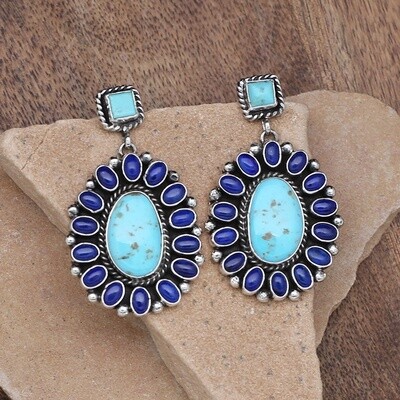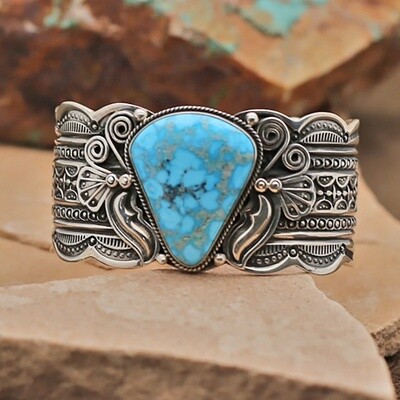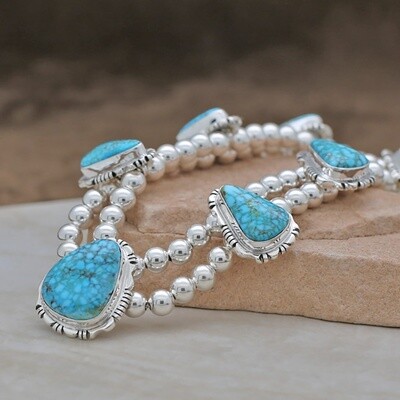Kingman spiderweb turquoise bracelet
SKU BC1253
$1,999.00
or four payments of $499.75 each byView details
In stock
1
Save this product for later
Customer reviews
No reviews yet. Only signed-in customers who bought this product can leave reviews. To leave a review, sign in
Kingman spiderweb turquoise bracelet
Product Details
Measuring 1" in width with approximately 6" on the inside and a 1" opening. This bracelet is made from high grade Kingman spiderweb turquoise. Set in solid sterling silver, this bracelet shows off the artist's signature detailed stamping. Entirely handcrafted by Navajo artist Andy Cadman. Navajo - Born in 1966, Andy Cadman creates beautifully stamped silver jewelry using a variety of stones and materials. He is the older brother of Darrell Cadman. Andy, his brothers Darrell and Donovan, and his half-brothers Gary and Sunshine Reeves all learned much of their trade from David Reeves (Gary and Sunshine's now deceased full brother). Therefore, all of the brother's silverwork exhibit much of the same characteristics and a common feel. The complex matrix webbing of the stone along with its "satin finish" of the silver give this piece a timeless look. Truly one of the best examples Navajo craftsmanship. KINGMAN SPIDERWEB TURQUOISE BRACELET BY: ANDY CADMAN American Turquoise also varies substantially from the different locations it is found. Turquoise is formed by moisture leaching down into the ground through the mineral rich soil. The liquid flows through and into crevasses and voids below the surface of the earth. Turquoise Nuggets form in a void within clay and Vein Turquoise from in cracks and voids in hard rock. It is also known for its spectacular matrix which comes from the host rock it was formed in. Turquoise can actually be identified from which Turquoise Mine it came from by the color and different elements of its matrix. Bisbee Turquoise is known for its beautiful chocolate brown to reddish brown matrix while Royston Turquoise is known for its golden colored matrix. Occasionally, a Spiderweb pattern matrix is found in Turquoise which is very desirable to collectors, Spiderweb Turquoise is rare and commands a substantially higher value when found. Kingman Turquoise originates in the Mineral Park Mining District near Kingman, Arizona. One of the largest domestic turquoise mines, it is found in a large open pit copper mine in the high desert country. The Kingman Mine district was first mined by Native Americans; it was part of the most extensive prehistoric workings in Arizona. However, modern production of turquoise dates back to the 1880's when James Haas rediscovered the area. Natural Kingman Turquoise ranges in color from light to very dark blue and sometimes tints of green. Matrix can range from white, light brown to black and frequently flecked with pyrite and occasionally quartz. The most famous stones from this mine are rounded bright blue nuggets with black matrix. Few turquoise mines produced nuggets, especially of this quality. In its high-grade form it has always been considered among the top-quality American turquoise. This high blue color has become a "color standard" in the industry, reflected by the name "Kingman Blue". However, much of the turquoise from Kingman occurs as seams, masses and veins, rather than in nugget form. Besides the nugget form, the most desirable Kingman turquoise is a deep blue with molybdenum pyrite; also, deep blue with pyrite as well as in a "bird's eye" pattern with "water web" matrix. The mine is currently owned & Operated by the Colbaugh family’s company, Colbaugh Processing. While old natural Kingman turquoise is rare, they have recently gone back into older sections of the Kingman mine and are bringing out some new natural Kingman Turquoise. Although there are quantities of this fine natural deep blue turquoise available, the largest percentage of turquoise mined at Kingman is being treated or stabilized. There are several other names for the turquoise coming out of the Kingman mining district: Ithaca Peak, Old Man Mine, Kingman Duval, Courtland, The Wall and Turquoise Mountain, just to mention a few.
You May Also Like
Display prices in:USD






